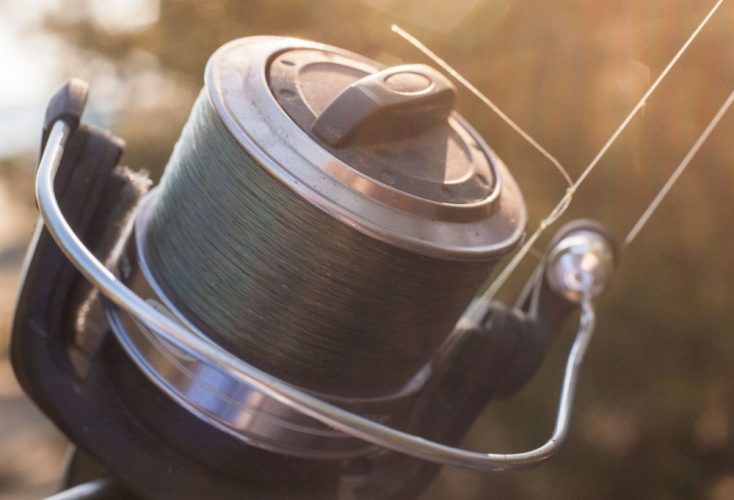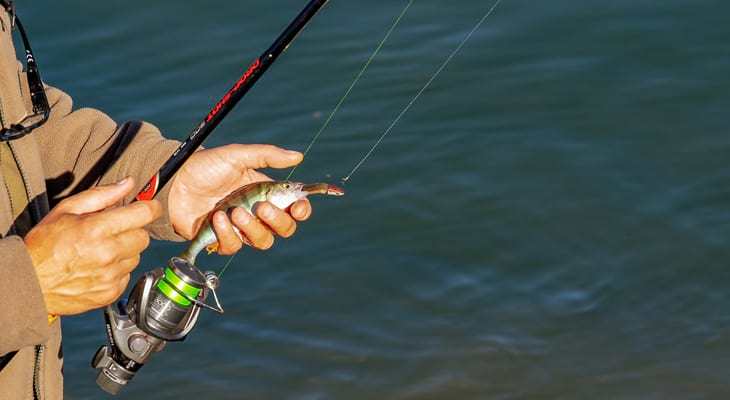To keep your fishing game at its peak, replace your monofilament fishing line every 4-6 months, a fluorocarbon line every 6-9 months, and a braided fishing line every 12-18 months.
However, these are general estimates and can vary based on your fishing habits and line maintenance.
| Line Type | Lifespan | Replacement Frequency |
|---|---|---|
| Monofilament | 4-6 months | Change every 4 months |
| Fluorocarbon | 6-9 months | Change every 6 months |
| Braided Line | 12-18 months | Change every 12 months |

Table of Contents
How Often Should I Change My Fishing Line?
I’ve learned the importance of changing my fishing line often. While the general rule of thumb is to replace monofilament every 4-6 months, fluorocarbon every 6-9 months, and braided fishing line every 12-18 months, it’s not one-size-fits-all.
Your line’s durability also hinges on how often and where you fish, how well you maintain your lines, and the species you target.
I tend to replace my line more frequently if I am angling in areas with a lot of cover or rocky bottoms, where line damage is more common. If you’re someone who hits the water multiple times a week, or if you’re fishing in tough conditions, you might want to change your line more often.

How Long Does Fishing Line Last?
Your fishing line’s lifespan depends on the line type and how well you care for it. Monofilament lines tend to last 4-6 months, while fluorocarbon and braided lines have longer lifespans, usually between 6-18 months. However, you should regularly inspect your line reel for signs of wear and tear.
I remember losing a big bass because I failed to notice the line’s deterioration. Trust me, nothing is more frustrating for an angler than seeing a trophy fish swim away due to line failure!
Why Does the Fishing Line Go Bad?
There are many different reasons that fishing line can become unfit for use, including abrasion damage, sun damage, line twist, and degradation.
Abrasion Damage: Nicks/Cuts/Kinks
One of the main reasons fishing lines need replacing is abrasion damage. Lines can develop nicks, cuts, and kinks when they come in contact with sharp rocks, debris, or fish teeth. Once, while fishing near a rocky area, my line broke because of several small cuts I hadn’t noticed.
Since then, I always check my line for signs of wear before every fishing trip.
Thicker fishing line is also less vulnerable to abrasion damage. This is why choose mono line helps when fishing around structure.
UV Sun Damage
Sun damage is another reason why fishing lines degrade. Ultraviolet rays can weaken the line, particularly monofilament and fluorocarbon lines. I’ve found that my lines last longer when I store my tackle in a cool, dark place away from sunlight.
Memory
Memory is an issue that can cause your fishing line to coil or loop, particularly with mono and fluoro lines. This happens when the line keeps the coiled shape it has on the reel. It’s something I had to deal with early on in my angling career, but luckily, certain tips and tricks can mitigate this problem.
This doesn’t happen with braid fishing line, which is why it tends to last much longer.
Overuse
Just like any other equipment, the more you use your fishing line, the faster it wears out. This is particularly true if you’re a frequent angler or if you’re casting long distances, which puts extra strain on the line. As a rule of thumb, if I’ve been using the same line for several fishing trips, I give it a thorough check for any signs of wear and tear.

High Temperatures
Exposure to high temperatures can also cause your fishing line to degrade, especially if it’s monofilament or fluorocarbon. I learned this the hard way when I left my fishing gear in the car on a hot summer day. The heat made the line brittle, and it snapped on my next cast. Now, I always make sure to store my gear in a cool place.
Incorrect Storage
Fishing line, if not stored properly, can easily deteriorate. One time, I stored my line reel in a damp basement, and the moisture seeped into the spool and damaged the line. It’s important to keep your gear in a dry, cool, and sun-free location to prevent degradation.
Chemical Exposure
Chemical exposure is another overlooked factor that can cause fishing line degradation. Repellents, gasoline, oil, and other harsh chemicals can cause lines, especially mono and fluoro lines, to weaken and become brittle. Always remember to wash your hands thoroughly after handling such substances before touching your fishing line.
Saltwater Damage
Saltwater can be harsh on fishing lines, leading to faster degradation. The salt particles can seep into the line and cause it to become brittle over time. That’s why I always make it a point to rinse my fishing gear with freshwater after every saltwater fishing trip.
Understanding these factors can help you better maintain your fishing line and identify when it’s time to change. It’s all about being observant and proactive to ensure your fishing line is always in the best possible condition.
How to Prolong the Life of Your Fishing Line?
Proper line care can help you squeeze out a few months from your fishing line. One of my main tips is to rinse your line after every use, especially if you’re fishing in saltwater. It helps remove salt, sand, and other particles that can degrade the line over time.
Regularly checking your line for any visible damage is another habit I strongly recommend. Even minor nicks or cuts can significantly reduce your line’s strength.
Lastly, storing your tackle correctly, in a cool, dry place away from sunlight, can also prolong your line’s lifespan.
Remember, fishing line is not designed to last forever. Regularly changing your fishing line is essential to angling, ensuring you always have a strong, reliable line ready for the next big catch.
And while it may seem like an inconvenience or an unnecessary expense, trust me when I say it’s better than losing a trophy fish due to line failure!
